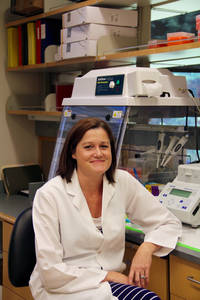 MedicalResearch.com Interview with:
Dr. Gary K Owens Ph.D
MedicalResearch.com Interview with:
Dr. Gary K Owens Ph.D
Robert M. Berne Cardiovascular Research Center
University of Virginia, Charlottesville, Virginia
Medical Research: What is the background for this study?
Dr. Owens: The leading cause of death in the USA and worldwide is cardiovascular disease with many of the clinical consequences including heart attacks (myocardial infarctions) and strokes being secondary consequences of atherosclerosis, commonly referred to as hardening of the arteries. Importantly, a heart attack is not caused by gradual narrowing of a large coronary artery by the atherosclerotic plaque, but rather is caused by acute rupture of a plaque that results in a catastrophic thrombotic event that can completely occlude a major coronary artery shutting off blood supply to a major heart region. Similarly, rupture of a plaque can result in formation of a
thrombus that breaks off and circulates to a cerebral vessel where it can occlude blood flow to a brain region leading to a stroke. As such, it is critical to understand the mechanisms that regulate the stability of plaques, and the likelihood of plaque rupture.
The general dogma among clinicians and cardiovascular researchers has been that atherosclerotic plaques that have an abundance of macrophages and macrophage-derived foam cells relative to smooth muscle cells (SMC), the cells that normally line all of your blood vessels, are less stable and more prone to rupture with subsequent clinical consequences. However, the evidence for this is based on use of methods that are unreliable in identifying which cells within the plaque are truly derived from macrophages versus SMC, and even more importantly, what mechanisms regulate phenotypic transitions of these cells that are critical in the pathogenesis of this disease. Indeed, results of studies in cultured smooth muscle cells and macrophages have shown that each cell can express markers of the other cell type in response to stimuli likely to be present within advanced atherosclerotic lesions while down-regulating expression of their typical cell selective markers. As such, previous studies in the field have likely mis-identified which cell is which in many cases.
The goals of our studies were to clearly identify which cells within advanced atherosclerotic lesions are derived from SMC, to determine the various phenotypes exhibited by these cells and their functional role in lesion pathogenesis, and to determine what regulates these phenotypic transitions.
(more…)
 MedicalResearch.com Interview with:
W. Michael Hooten, M.D
Professor of Anesthesiology
Mayo Clinic
Medical Research: What is the background for this study?
Dr. Hooten: The purpose of the study was to investigate a gap in knowledge related to the progression of short-term opioid use to longer-term use.
Medical Research: What are the main findings?
Dr. Hooten: The main findings are that a history of substance abuse or tobacco use is associated with the progression from short-term to a longer-term pattern of opioid prescribing.
(more…)
MedicalResearch.com Interview with:
W. Michael Hooten, M.D
Professor of Anesthesiology
Mayo Clinic
Medical Research: What is the background for this study?
Dr. Hooten: The purpose of the study was to investigate a gap in knowledge related to the progression of short-term opioid use to longer-term use.
Medical Research: What are the main findings?
Dr. Hooten: The main findings are that a history of substance abuse or tobacco use is associated with the progression from short-term to a longer-term pattern of opioid prescribing.
(more…)







![Prof. Dr. Kristian Reich, Dermatologikum Hamburg, Hamburg 07.04.2009 | Prof. Dr. Kristian Reich, Dermatologikum Hamburg, Hamburg, Germany, 07.04.2009 | [© (c) Martin Zitzlaff, Emilienstr.78, 20259 Hamburg, Germany, Tel. +491711940261, http://www.zitzlaff.com, martin@zitzlaff.com, Postbank Hamburg BLZ 20010020 Kto.-Nr. 10204204, MwSt. 7%, Veroeffentlichung nur gegen Honorar (MFM) und Belegexemplar, mit Namensnennung]](https://medicalresearch.com/wp-content/uploads/Professor-Reich.jpg)











